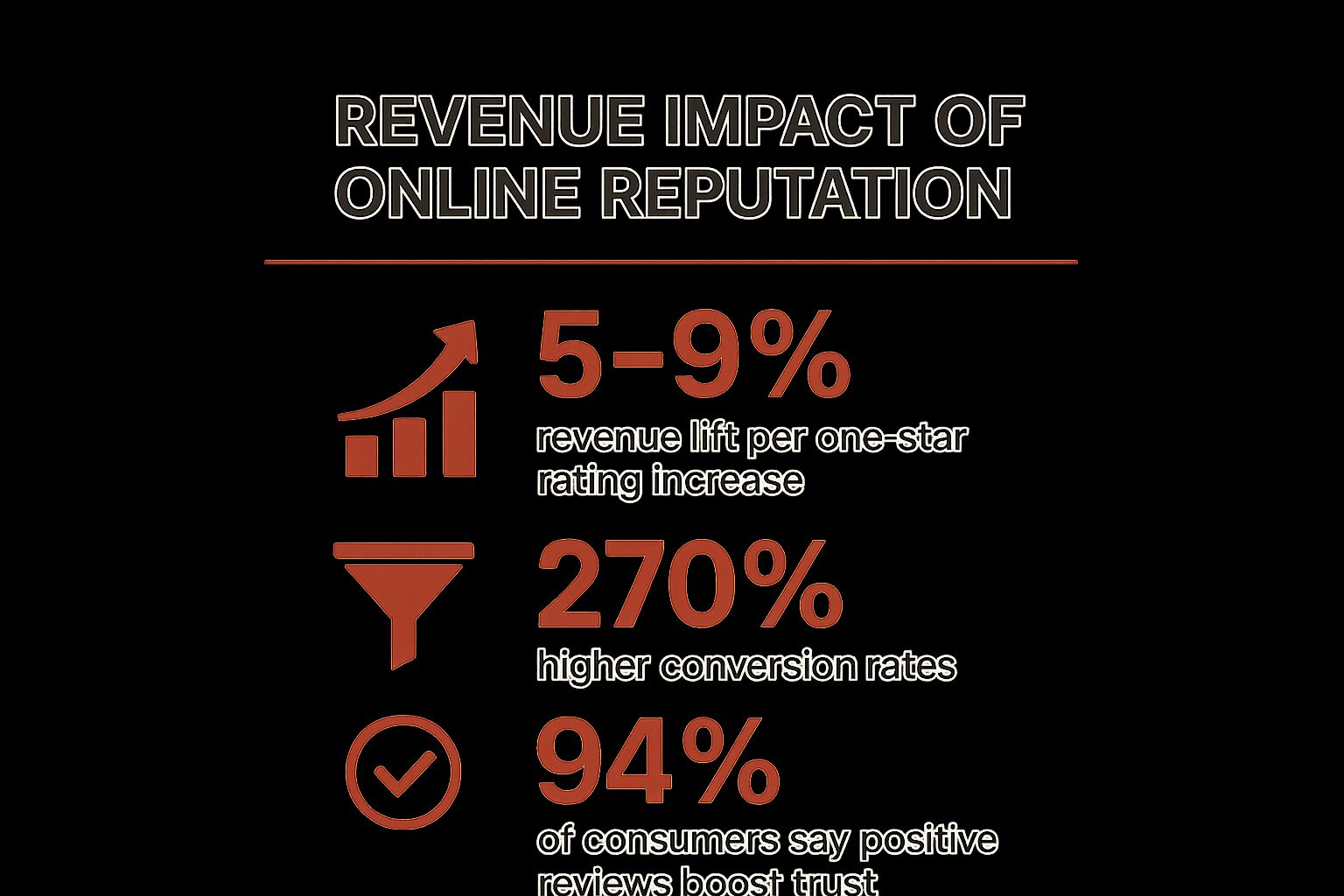In a digital-first world, your online reputation isn't just a part of your brand—it is your brand. Before a potential customer ever visits your store, calls your office, or clicks 'buy,' they have already formed an opinion based on what they find on Google, review sites, and social media. This digital first impression is everything. For small business owners and startups, managing this perception is critical for survival and growth.
What if you could actively shape that story, build trust before the first interaction, and turn your reputation into a powerful engine for growth? That's where online reputation management (ORM) comes in. It's not just about damage control; it's a proactive strategy for building a resilient, trusted, and profitable brand identity. Mastering this is key to building a strong digital presence. For practical strategies on safeguarding this asset, explore these 8 B2B SaaS reputation management tips for 2025.
This article breaks down the most significant advantages of online reputation management, providing a clear roadmap to transforming your digital footprint. We will explore how a deliberate ORM strategy can enhance credibility, improve search visibility, and drive real business results, turning your reputation from a potential liability into your most valuable asset.
1. Enhanced Brand Credibility and Trust
One of the most significant advantages of online reputation management is its direct impact on building and maintaining brand credibility. In today's digital marketplace, your online presence often serves as your first impression. A proactive ORM strategy ensures that when potential customers search for your business, they find positive, accurate, and consistent information that fosters immediate trust.
Think about it: a well-managed reputation, shown through positive reviews, thoughtful responses to feedback, and a professional social media presence, establishes a foundation of trust before a customer ever interacts with your product or service. This is vital, as studies consistently show that the vast majority of consumers read online reviews before making a purchase. A strong, positive digital footprint directly leads to higher conversion rates and customer loyalty.
For example, Patagonia has built legendary credibility by ensuring its online presence consistently reflects its core environmental values, from its content marketing to its transparent handling of supply chain issues. This alignment between words and actions creates an authentic brand that customers trust completely.
How to Implement This:
To actively build credibility and trust, focus on controlling your brand's story across all digital channels. This isn't about faking perfection; it's about showcasing authenticity and responsiveness.
- Claim and Optimize Listings: Take ownership of your profiles on all relevant review sites like Google, Yelp, and industry-specific platforms. Ensure all information is accurate and complete.
- Respond Promptly: Aim to respond to all reviews, both positive and negative, within 24-48 hours. This shows you are engaged and value customer feedback.
- Showcase Social Proof: Prominently feature customer testimonials, case studies, and user-generated content on your website and social media.
- Develop Value-Driven Content: Create blog posts, videos, or guides that demonstrate your expertise and commitment to your brand values, reinforcing your authority in your field.
By managing these elements, you create a digital ecosystem that validates your brand's promises. Further explore how platforms like GoodKudos can contribute to building a strong, positive brand image and foster greater trust by centralizing and amplifying customer feedback.
2. Improved Search Engine Visibility and Control
Another core advantage of online reputation management is the ability to strategically influence what appears when someone searches for your brand. Effective ORM involves creating and promoting positive, high-quality content to dominate the first page of search engine results pages (SERPs), while pushing any negative or irrelevant information further down where it is less likely to be seen. This gives you greater control over your brand's digital story.
This is crucial because most users, up to 75%, never click past the first page of search results. This means the top 10 results effectively become your brand's online identity. A proactive ORM strategy ensures these critical digital "billboards" showcase your business in the best possible light, directly shaping public perception and building a strong, positive first impression.
For example, Nike consistently maintains top SERP positions by strategically publishing content across its owned properties, major news outlets, and social media channels. When you search for "Nike," you find official websites, new product announcements, and positive news stories, all of which are a direct result of a concerted effort to control their search visibility.
How to Implement This:
To improve your search engine visibility and control, focus on creating a portfolio of positive, branded digital assets that can rank for your company’s name. This process is about building a digital moat around your brand's reputation.
- Create Multiple Branded Properties: Secure and optimize profiles on platforms like LinkedIn, Medium, YouTube, and other industry-relevant sites. These high-authority domains often rank well for brand searches.
- Publish Consistent, Optimized Content: Regularly produce high-quality blog posts, articles, and press releases that are optimized for your brand keywords. This creates a steady stream of positive, indexable content.
- Build Backlinks to Positive Assets: Actively build links from authoritative sources to your positive content (your website, positive reviews, favorable press) to boost their search engine rankings.
- Monitor SERP Rankings: Use a tracking tool to monitor your brand’s search results weekly. This allows you to identify new negative content quickly and adjust your strategy to address it before it gains traction.
3. Crisis Prevention and Rapid Response Capability
One of the most critical advantages of online reputation management is its function as an early warning system. A proactive ORM strategy establishes monitoring systems and response protocols that detect potential crises early, enabling swift, coordinated action before a small issue snowballs. By continuously tracking brand mentions across social media, review sites, and forums, businesses can identify and address emerging problems while they are still manageable.

In an era where negative information spreads in minutes, this rapid response capability is not a luxury; it is essential business protection. Having pre-planned strategies means the difference between a minor customer service hiccup and a viral PR disaster that causes lasting brand damage. The ability to act decisively and transparently can turn a potential negative into a demonstration of excellent customer care.
For instance, KFC UK masterfully handled a chicken shortage crisis by quickly launching a humorous and self-aware 'FCK' apology campaign. This rapid, honest, and creative response disarmed critics and ultimately generated positive sentiment, turning a logistical failure into a public relations victory.
How to Implement This:
To build a robust crisis prevention framework, you must combine technology with a clear, pre-approved plan of action. This ensures your team can act quickly and confidently when a problem arises, without waiting for high-level approvals.
- Set Up Real-Time Alerts: Use monitoring tools to create instant alerts for your brand name, key products, and executive names, especially when paired with negative sentiment keywords.
- Create a Crisis Communication Plan: Document a step-by-step plan that outlines roles, responsibilities, and pre-approved messaging for various potential scenarios.
- Establish Escalation Procedures: Clearly define what constitutes a minor issue versus a major crisis and who needs to be involved at each level.
- Respond Publicly, Then Resolve Privately: Acknowledge the issue publicly to show you are addressing it, then invite the user to a private channel like DMs or email to resolve the specifics.
By preparing for the worst, you empower your team to perform at its best under pressure. Mastering these online reputation management best practices is fundamental to protecting your brand's long-term health and stability.
4. Increased Revenue and Customer Acquisition
A strong online reputation is not just a feel-good metric; it is a powerful engine for growth that directly impacts your bottom line. One of the most tangible advantages of online reputation management is its ability to influence purchasing decisions at the most critical moments of the customer journey. When potential customers are evaluating their options, they inevitably turn to online reviews, ratings, and social proof, consistently choosing brands with a more positive and trustworthy digital presence.
This infographic highlights the direct correlation between a positive reputation and key business growth metrics.

These statistics reveal how a well-managed reputation transforms from an intangible concept into a quantifiable revenue driver. Think of it this way: for a local restaurant, improving their Yelp rating from 3 to 4 stars can result in an average revenue increase of 13%. Similarly, an e-commerce brand like Chewy.com builds a legendary customer service reputation that fuels word-of-mouth referrals, a powerful and cost-effective acquisition channel. ORM optimizes every digital touchpoint where a customer forms a buying decision, making it a crucial investment for sustainable growth.
How to Implement This:
To turn your reputation into a revenue-generating asset, you must systematically leverage positive customer feedback and integrate it into your sales and marketing funnels. This involves actively seeking out and showcasing the voice of your happy customers.
- Systematize Review Requests: Implement an automated process to ask for reviews after a successful purchase or positive service interaction. Timing is key to capturing customer enthusiasm.
- Display Reviews Prominently: Embed positive reviews and star ratings directly on your product pages, landing pages, and checkout process to reduce friction and build confidence.
- Utilize Review Schema: Work with your developer to add schema markup to your website. This enables star ratings to appear directly in Google search results, dramatically increasing click-through rates.
- Focus on Review Velocity: Prioritize a steady stream of new reviews over just a high volume. Recent feedback is more relevant and trustworthy to prospective customers.
5. Competitive Differentiation and Market Positioning
In a crowded marketplace, where products and services often appear similar, your online reputation becomes a powerful competitive differentiator. Effective online reputation management allows you to strategically position your brand against competitors by highlighting what makes you unique, from stellar customer experiences to your core company values. This is one of the key long-term advantages of online reputation management.
When potential customers are comparing their options, a superior online reputation can be the deciding factor. The brand with overwhelmingly positive reviews, responsive social media engagement, and a clear, authentic voice often wins the business, even if its prices are higher or features are comparable. This advantage is crucial in local markets where businesses vie for the same customer base and in B2B industries where reputation signals reliability and expertise.
For example, the legendary customer service reputation of Zappos, championed by founder Tony Hsieh, allowed it to stand out in the crowded online shoe market. This focus on reputation was so effective it became the company's core differentiator, ultimately leading to its acquisition by Amazon. Similarly, In-N-Out Burger's cult-like reputation for quality and simplicity allows it to thrive against much larger fast-food chains.
How to Implement This:
To use your reputation as a competitive tool, you must actively identify your unique strengths and ensure they are consistently communicated across all your digital channels. This involves shaping a narrative that sets you apart from the rest.
- Conduct Competitive Audits: Regularly analyze your competitors' online reputations. Look at their review profiles, social media sentiment, and content to identify gaps and opportunities where your brand can excel.
- Highlight Your Differentiators: Encourage customers to leave reviews that mention your unique strengths, such as exceptional service, product quality, or fast shipping. Showcase these testimonials prominently.
- Position as an Expert: Create content like guides, webinars, or in-depth articles that establishes your authority and positions your brand as the go-to resource in your industry.
- Build a Community: Foster a community around your brand's shared values. This creates a loyal following that is less likely to be swayed by competitors' offers.
By focusing on these strategies, you can transform your online reputation from a passive asset into an active driver of market positioning and growth. Platforms designed for reputation management can help you gather and analyze competitor data, giving you the insights needed to sharpen your competitive edge.
6. Valuable Customer Insights and Business Intelligence
Beyond managing public perception, one of the core advantages of online reputation management is its ability to function as a powerful business intelligence tool. The continuous stream of unfiltered customer feedback from reviews, social media comments, and forum discussions provides a direct line to what your audience truly thinks about your products, services, and overall experience.
This raw, honest feedback is often more valuable than traditional surveys. Systematically analyzing this data reveals customer pain points, highlights service gaps, uncovers emerging needs, and identifies your brand's key strengths. This information is crucial for making informed decisions across your entire organization, turning reputation management into a competitive intelligence operation.
For instance, Microsoft actively uses customer feedback from forums and software reviews to prioritize new feature development and bug fixes for its products. Similarly, Hotels.com analyzes millions of user reviews to provide travelers with specific insights like "great for families" or "quiet rooms," directly improving their user experience and booking process by leveraging existing customer data.
How to Implement This:
To transform customer feedback into actionable business intelligence, you must create a structured process for collecting, analyzing, and distributing insights. This turns passive monitoring into an active strategy for improvement.
- Categorize All Feedback: Systematically tag and categorize incoming feedback by theme, such as product quality, customer service, pricing, or shipping, to identify recurring issues.
- Create Insight Reports: Develop monthly or quarterly reports that summarize sentiment trends, highlight top customer complaints and praises, and track how specific changes affect subsequent reviews.
- Establish Feedback Loops: Share these insights directly with relevant departments. Product teams can use feedback for development, marketing can refine messaging, and operations can address service gaps.
- Use Analytics Tools: Leverage text analytics and sentiment analysis tools to efficiently process large volumes of reviews and comments, quickly identifying key patterns and trends.
By treating online feedback as a data source, you can refine your strategies and better align your business with customer expectations. These insights can also significantly enhance your marketing efforts; find out how by exploring how to create buyer personas using customer data.
7. Talent Attraction and Employee Retention
Beyond attracting customers, one of the most powerful advantages of online reputation management is its direct influence on attracting and retaining top-tier talent. In today's competitive job market, your company's online reputation is a primary factor for potential employees. They research your brand on platforms like Glassdoor, LinkedIn, and even social media to gauge what it's truly like to work for you before ever submitting an application.

A positive employer brand, characterized by authentic employee reviews and a transparent portrayal of company culture, becomes a significant recruiting asset. It reduces hiring costs and time-to-hire by creating an inbound pipeline of qualified candidates who are already aligned with your values. For example, Costco's stellar reputation for treating its employees well has resulted in an employee turnover rate of just 5-6%, a fraction of the 60% retail industry average. This demonstrates how a strong external reputation fosters internal pride and loyalty.
This strategic focus on employer branding doesn't just fill open roles; it builds a more engaged and productive workforce. When employees are proud of where they work, they become brand advocates, which in turn reinforces a positive public perception and creates a virtuous cycle of success.
How to Implement This:
To leverage your reputation for talent acquisition and retention, you must actively manage your employer brand narrative. This involves showcasing your company culture and ensuring the external perception matches the internal reality.
- Manage Employer Profiles: Claim and actively manage your company profiles on Glassdoor and Indeed. Keep information updated and engage with the community.
- Encourage Honest Feedback: Ask current, satisfied employees to share their genuine experiences by leaving reviews on relevant platforms.
- Respond Professionally: Address all employee reviews, especially negative ones, with empathy and a commitment to improvement. This shows you listen and value feedback.
- Showcase Your Culture: Use your website's career page and social media channels to feature employee stories, team events, and content that highlights your company values in action.
- Be Transparent: Openly discuss your company’s challenges and the steps you are taking to address them. Authenticity builds far more trust than a facade of perfection.
8. Long-term Brand Equity and Asset Value
Beyond immediate sales and customer sentiment, one of the most powerful advantages of online reputation management is its ability to build long-term, tangible financial value. A strong digital reputation is not just a marketing tool; it is a significant intangible asset that directly contributes to your company's overall valuation. It's a compounding investment that appreciates over time, providing stability and competitive leverage.
Think of your online reputation as digital real estate. A positive, well-managed presence, filled with strong reviews and authentic customer engagement, increases your brand's market value. During mergers, acquisitions, or funding rounds, due diligence increasingly scrutinizes a company's online standing. A pristine reputation can lead to a premium valuation, while a poor one can derail a deal entirely. This asset provides resilience during crises and builds a foundation of trust that can be leveraged for future growth.
For example, when Unilever acquired Dollar Shave Club, they weren't just buying a razor subscription service; they were acquiring a powerful brand with a beloved online reputation and a fiercely loyal digital community. Similarly, a significant portion of Apple's multi-trillion-dollar valuation is tied to its brand equity, which is meticulously protected and cultivated across every digital touchpoint. This reputation allows them to command premium prices and enter new markets with immediate credibility.
How to Implement This:
To transform your reputation into a measurable asset, you must approach ORM as a long-term investment rather than a short-term, reactive tactic. It requires a strategic and consistent effort to build and protect this value.
- Integrate Reputation into Financials: Work with your financial team to begin tracking reputation metrics and explore models for including this intangible asset in your company's valuation.
- Document and Archive: Maintain a historical record of your online reputation, including key positive reviews, press mentions, and customer testimonials. This documentation can serve as evidence of your brand's value over time.
- Leverage Equity for Growth: When launching a new product or expanding into a new market, strategically use your existing positive reputation to build initial trust and accelerate adoption.
- Protect It Like a Physical Asset: Implement proactive monitoring and crisis management plans to defend your reputation just as you would protect your physical inventory or intellectual property.
Advantages Comparison of 8 Key Online Reputation Benefits
| Aspect | Enhanced Brand Credibility and Trust | Improved Search Engine Visibility and Control | Crisis Prevention and Rapid Response Capability | Increased Revenue and Customer Acquisition | Competitive Differentiation and Market Positioning | Valuable Customer Insights and Business Intelligence | Talent Attraction and Employee Retention | Long-term Brand Equity and Asset Value |
|---|---|---|---|---|---|---|---|---|
| Implementation Complexity 🔄 | Moderate: ongoing content & reputation management | High: requires SEO expertise and technical skills | High: needs 24/7 monitoring, alert systems & teams | Moderate: needs review campaigns & SEO integration | Moderate-High: continuous audits & content creation | Moderate: requires data analytics tools & expertise | Moderate: managing employer profiles & culture messaging | High: long-term consistent investment and protection |
| Resource Requirements ⚡ | Continuous monitoring and engagement | SEO tools, content creation, backlink building | Monitoring tools, trained response teams, alert systems | Review management systems and content marketing | Competitive audits, content production, community building | Analytical tools for sentiment & trend analysis | Employer branding platforms, employee engagement content | Investment in long-term brand building & evaluation |
| Expected Outcomes 📊 | Increased trust, positive brand perception ⭐⭐⭐⭐ | Higher organic visibility and control over SERPs ⭐⭐⭐⭐ | Faster crisis mitigation, reduced damage ⭐⭐⭐⭐ | Revenue uplift, higher conversions, lower CAC ⭐⭐⭐⭐⭐ | Differentiation, premium pricing, market leadership ⭐⭐⭐⭐ | Deeper business insights, improved product & marketing | Better talent acquisition and retention ⭐⭐⭐⭐ | Enhanced valuation, brand resilience, customer loyalty ⭐⭐⭐⭐ |
| Ideal Use Cases 💡 | Businesses needing trust building & social proof | Brands aiming to dominate search results | Companies vulnerable to rapid negative publicity | Those focused on direct ROI from reputation | Companies in competitive or saturated markets | Organizations seeking actionable customer feedback | Employers wanting to improve recruitment & employee morale | Companies focused on long-term brand value growth |
| Key Advantages ⭐ | Builds authenticity & social proof | Controls brand narrative & boosts branded search traffic | Early problem detection & rapid coordinated response | Directly measurable financial impact | Creates defensible competitive moats | Provides continuous, authentic customer intelligence | Reduces hiring costs, attracts quality talent | Creates sustainable competitive advantage & premium valuation |
Taking Control of Your Brand's Story
Navigating the digital landscape can feel like trying to steer a ship in a storm. Voices come from every direction: glowing reviews, disgruntled customer feedback, competitor mentions, and social media chatter. As we've explored, leaving your brand’s story to chance is no longer a viable strategy. The core message is clear: the many advantages of online reputation management all converge on a single, powerful concept—control.
It's about transforming your digital presence from a passive reflection of public opinion into an active, intentionally crafted asset. It’s the difference between letting others tell your story for you and confidently holding the pen yourself.
From Reactive Defense to Proactive Growth
Too often, businesses only think about their reputation when a crisis hits. But a proactive approach changes the game entirely. It’s not just about damage control; it’s about building a fortress of trust and credibility so strong that minor issues bounce off without leaving a mark.
Let's distill the key takeaways from this guide:
- Trust is Your Currency: Building unwavering brand credibility is the foundation. Every positive review you encourage and every negative comment you address constructively adds to this trust bank.
- Search Is Your Storyteller: Dominating search engine results for your brand name means you control the first impression for the vast majority of potential customers, investors, and future employees.
- Insights Drive Innovation: Your online reputation is a goldmine of business intelligence. Listening to customer feedback provides direct, unfiltered insights that can guide product development, improve service, and reveal market gaps.
- Reputation Fuels Revenue: Ultimately, a stellar reputation directly impacts your bottom line. It boosts customer acquisition, improves retention, and justifies premium positioning in a crowded market.
Your Next Steps: Building Your Digital Legacy
Embarking on a dedicated online reputation management strategy can seem daunting, but it starts with small, consistent actions. Begin by conducting a thorough audit of your current online presence. Set up listening tools to monitor mentions of your brand. Most importantly, create a formal process for gathering and responding to customer reviews.
These actions are not just checklist items; they are the building blocks of long-term brand equity and sustainable growth. A strong reputation protects you during downturns and accelerates your success during periods of growth. It becomes one of your most valuable, enduring assets. You have the power to shape how the world sees your business. The time to start building that legacy is now.
Ready to move from defense to offense and build a reputation that drives real business results? The team at Digital Lotus Marketing specializes in crafting and protecting digital legacies for businesses just like yours. Let us help you take control of your narrative and turn your online presence into a powerful growth engine.






